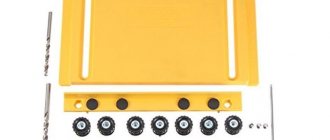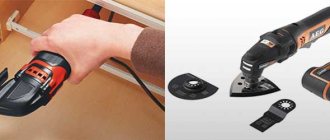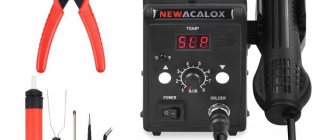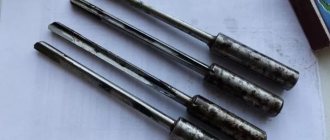Very often, when repairing furniture or assembling it, you need to accurately drill holes for the firmmat, dowel and other fasteners. If you drill a sheet of chipboard, it is almost impossible to do this with a simple drill, since the hole breaks and it is not always possible to make a right angle. Therefore, for such work you must have a tool called a conductor.
Classification of conductors
The main function of jigs is to ensure straightness in drilling wooden surfaces throughout the entire depth of the hole. Such devices are used quite often in metal processing and, as a rule, are supplied directly with the machine. Due to the need to create such holes in furniture production in large quantities, such devices are in great demand among craftsmen.
There are the following types of conductors:
- Invoices. This type does not require fixation before starting work. They are practical and simple, but they should only be used with one hand unless the drill is mounted on a special stand. You can make such a conductor yourself easily and simply, but it must be used in chipboards.
- Rotary. With their help, you can make two holes in planes that are adjacent to each other. This operation is performed thanks to a folding bracket.
- Jig for drilling holes at an angle. This option is used in highly specialized industries. It can be used to drill holes at an angle. Sometimes used in conjunction with slip-on conductors.
- Sliding. They are designed to drill holes in multiple locations while keeping the original settings the same. They are mainly used by professionals and require little experience to operate successfully.
If the jig has sufficient rigidity, then it can be used not only on flat planes, but also for curved pipes, etc. In this case, it is secured with a clamp. But under no circumstances should it be used for fastening on wooden surfaces, as it can damage the furniture. You can buy it in a store, or you can also make it yourself.
The jig is in fact a template for making holes, with the help of which such work can be done with maximum accuracy. Due to the simplicity of the structure, they are often used not only in the areas of furniture production. In particular, they are actively used in the field of mechanical engineering for drilling holes in various workpieces, etc. We should not forget about the furniture industry, where such a device is used for various needs when assembling furniture fittings.
Conductors for high-quality drilling of holes
Any jig for drilling furniture holes is a template in the form of a strip or sheet. It can be narrow or wide and have different shapes. Regardless of the shape and size, each template has holes of a certain diameter - it is through them that furniture is drilled.
When manufacturing and assembling furniture “on-line”, the use of a template is an immediate necessity. You should buy a conductor to:
- speed up work processes;
- increase drilling accuracy;
- make the work of furniture makers and assemblers easier.
Using a conductor makes it possible to avoid errors and inaccuracies, minimize the amount of defects, and achieve the highest quality work. And by reducing the workload on workers and speeding up processes, you increase labor productivity and overall efficiency, which has a positive effect on the final financial result.
Features of self-production
When designing a conductor for confirmation, it is necessary to correctly calculate what functions it will have to perform in the future. It should be done for the most commonly used fasteners in the house. If such a device is required by furniture makers for constant work, then it is better to buy a factory model, which is distinguished by great precision. In addition, manufacturers often include additional fasteners, stops and templates in the kit.
Tools for drilling holes at angles
Let's start with a description of the consoles.
Guide attachments for drilling holes at angles
Attachments for drilling holes at angles are structures consisting of:
- stanine;
- guides;
- carriages moving along them, serving to fix drills;
- handles
Photo No. 1: drill attachment
The frame has a cutout at an angle of 45°. It is designed for fixing pipes and cylindrical workpieces.
Photo No. 2: drilling a cylindrical workpiece using an attachment
These devices are available for household, semi-professional and professional use.
- Devices of the first type only have the function of adjusting the tilt of the guides to set the desired drilling angle. The structures are held in place using handles.
- Semi-professional attachments for drilling holes at an angle can be equipped with additional devices such as frame fixation systems and drilling depth regulators. Some models have the ability to change the drilling angle both along and across the plane of the workpiece. Due to the presence of additional devices, such attachments are more cumbersome.
- Professional models. Additional accessories may also vary. The main difference between professional attachments is the presence in the designs of their own chucks for fixing drills. This solution increases the accuracy of the resulting holes and also extends the service life of drills and drill bits.
Image #1: Professional attachment for drilling holes at an angle
Jigs for drilling holes at angles
Conductors (or templates) are auxiliary devices of various designs that are used when it is necessary to drill precise holes of various diameters in metal and other materials at various angles.
Devices are divided into 2 main types.
- Jigs designed for drilling holes at right angles.
- Devices for drilling holes at acute and obtuse angles.
Photo No. 3: overhead jig for drilling holes at right angles
In addition, jigs for drilling holes at angles are divided into different types according to two criteria.
1. Scope of application.
- Universal. Standard models made of steel. Suitable for solving most problems.
- Furniture. Designed for drilling holes for furniture assembly, mounting, fittings, etc.
- Conductors for crowns. These are special models designed for drilling holes at angles not with ordinary drills and drills, but with large-diameter diamond core bits.
- Devices for drilling tiles and tiles. Equipped with water supply systems for cooling diamond drills.
- Pipe models. Designed for drilling cylindrical workpieces.
2. Method of application.
- Invoices. Such jigs for drilling holes at angles are used when processing workpieces with flat surfaces. The devices are held by hand or securely fixed.
- Sliding. Such devices are not fixed. They are held by hand when used.
- Rotary. They are used when drilling holes in cylindrical parts. The drilling direction is set using bushings. It can be vertical, horizontal and inclined.
- Tiltable. Such jigs for drilling at angles are used when it is necessary to work in different planes.
- Pinned. They are securely attached to the surfaces being treated. This is convenient, but limits freedom of action.
Image No. 2: drilling metal using a jig
Design for confirmations and dowels
A furniture jig for drilling holes for dowels and confirmations is a very necessary device for furniture makers. Especially if chipboard material is used.
For these purposes, two types of conductor are used:
- Dowel jig with clamp fastening with many functions. The basis of this design is a corner made of thick aluminum. Since the device is quite long, there is an additional fastener in the middle. When turning the angle ninety degrees, the increased thickness of the device helps a lot. The bushings on the structure are located at the distance most often used for confirmations and dowels in furniture production.
- A two-slider jig, which is used to make a hole in two parts fastened together. The design consists of two strips that are connected by fasteners. It has several holes, so you can install devices at different widths.
Features of application in the furniture industry
Conductors and templates are needed when assembling furniture. These things will prevent you from having a common problem that occurs during drilling—the drill hitting the part at the wrong angle. Correcting such an error will take an extremely long time, in some cases it will even be impossible.
A jig for making holes will not only allow you to correctly orient the working tool, but will also prevent it from straying from the desired trajectory.
In the furniture industry, jigs and templates are used in the following cases:
- in mass production;
- when assembling structures, when it is necessary to make holes for fasteners in the parts being connected. In this case, a jig for drilling holes for dowels or confirmat is suitable;
- a jig for drilling holes at an angle is used both in such cases and when working with thin boards, for example, MDF or chipboard.
When using such a device, the assembly process will be much easier and faster; you will be able to make the necessary holes regardless of how far they should be located from the edge of the part and how wide it is.
When assembling furniture yourself, you often have to connect parts end-to-end using dowels. Holes for dowels are best made using a special jig. The peculiarity of dowels is that despite the fact that such fasteners, although outdated, are still relevant in furniture production.
The difficulty in their use lies in the fact that the axes of the holes that are made in the parts when connecting must have a right angle with each other. Accordingly, they must be placed strictly perpendicular to each other. It is difficult to do this without a special device. Therefore, if you want to achieve high quality performance, it is recommended to buy a dowel jig.
Scope of use
Furniture jigs are devices that no furniture maker can do without while working. Such devices allow you to avoid the main problem in furniture production, namely the drill entering at the wrong angle. If you make such a mistake, it is very difficult or even impossible to correct it later. Such a device not only makes it possible to correctly direct the drill during operation, but also allows the tool to constantly maintain the desired trajectory (flat, perpendicular or at an angle).
Such devices are used both in the design and production of furniture, and during assembly, when there is a need to make holes for fastening elements together. Often, for such actions, conductors are used for firmmats or dowels, without which it is impossible to make straight holes. Also, you cannot do without this device if you need to make holes at an angle or in the end of a thin slab (it is especially important to use the device when working with chipboards).
When drilling holes using this design, the process itself is quick and simple. The fastener allows you to do work at any distance from the edge of the slab, as well as regardless of its width.
In the furniture industry, dowels are often used as fasteners. But at the same time, this option has already existed for a long time, and their use requires the presence of a drilling jig when working. The only condition and at the same time a problem is the fact that the parts being connected to each other must have a right angle during operation. Therefore, such elements must be located exactly perpendicular to each other. When making holes for dowels and adding parts, it will be very difficult to do without a jig.
The best jigs for drilling at an angle
Such models can be fixed on curved workpieces and end elements. To do this, they use clamps and stops of various types, which allows them to be used not only when drilling, but also when installing hinges or fastening complex structures.
Kreg K4
5
★★★★★
editorial assessment
100%
buyers recommend this product
The model uses Drill Guides with three holes for processing materials with a thickness of 13 to 38 millimeters. All structural blocks have hardened steel inserts. They minimize drill deviations, chipping and scratches.
Kreg Face Clamps are multi-purpose clamps that quickly secure a jig to a table. The clamp is adjusted using a lock nut. The body is made of nylon and reinforced with fiberglass, which guarantees high strength, but at the same time elasticity and flexibility.
Advantages:
- precise drilling angle;
- careful processing;
- reliable fixation;
- waste disposal;
- flexible setup.
Flaws:
- price.
Kreg K4 is suitable for regular use - joining furniture parts or repair work.
Wolfcraft 4640000
4.9
★★★★★
editorial assessment
94%
buyers recommend this product
The model has an easy-to-grip handle that provides comfortable holding at any angle. The shock-resistant design is not afraid of falls from great heights and mechanical damage.
Acceptable dowel diameters are 6, 8 and 10 mm, the thickness of the workpiece can be up to 30 millimeters. The jig guarantees perfect alignment of the parts to be fastened, does not scratch the surface and is convenient for intensive drilling.
Advantages:
- ease of holding;
- robust design;
- tight fit to the surface;
- durability.
Flaws:
- heavy.
Wolfcraft 4640000 will be useful when preparing connections using dowels. Accordingly, it is used to work with chipboard, plywood, MDF and solid boards.
KWB DubelProfi 7580-00
4.8
★★★★★
editorial assessment
91%
buyers recommend this product
The model is equipped with a rubber backing that protects smooth surfaces from scratches. The revolving type drum ensures easy reconfiguration of the device.
With dimensions of 283x139x171 mm, the conductor weighs 300 grams. The rip fence and feeler gauge facilitate precise, clean drilling, while the marking scale makes heavy-duty work easier. The model allows you to choose a hole with a diameter from 3 to 12 millimeters.
Advantages:
- flexible setup;
- soft backing;
- light weight;
- versatility;
- reliable fixation.
Flaws:
- Not a particularly strong body.
KWB DubelProfi 7580-00 is suitable for solving problems of varying levels of complexity. These include drilling holes in pipes and installing corner and flat joints.
READ ALSO
15 Best Impact Drills
Narex 872100
4.7
★★★★★
editorial assessment
85%
buyers recommend this product
The model is small in size and weight. This ensures comfortable use in awkward positions or hard-to-reach places. The kit includes a wood drill bit with a diameter of 8 millimeters.
The curved shape of the handle and the depression in the central part contribute to a tight fit of the conductor and eliminate the possibility of the nozzle slipping. The depth limiter guarantees more accurate work.
Advantages:
- compactness and light weight;
- depth limiter;
- tight fit to the surface;
- ease of holding;
- drill included.
Flaws:
- wears out quickly.
Narex 872100 is worth buying for accurately drilling holes for furniture dowels. Economical solution when working with similar connections.
What can you use at home?
At home, you usually have to drill holes at right angles. To increase accuracy, you can use two effective means at hand.
Metal corner
This is the most common device for drilling holes at an angle of 90°. It is used like this.
- Make markings using a core.
- Take a drill and place the drill in the center of the future hole.
- Attach the angle to the drill so that it is in contact with the tool on both sides.
- Drill a hole to the required depth.
Extended nut
Holes made by drilling metal at right angles using an extended nut are also highly accurate. The operation only involves holding a device of the required diameter while drilling and centering the drill at the intended point.











